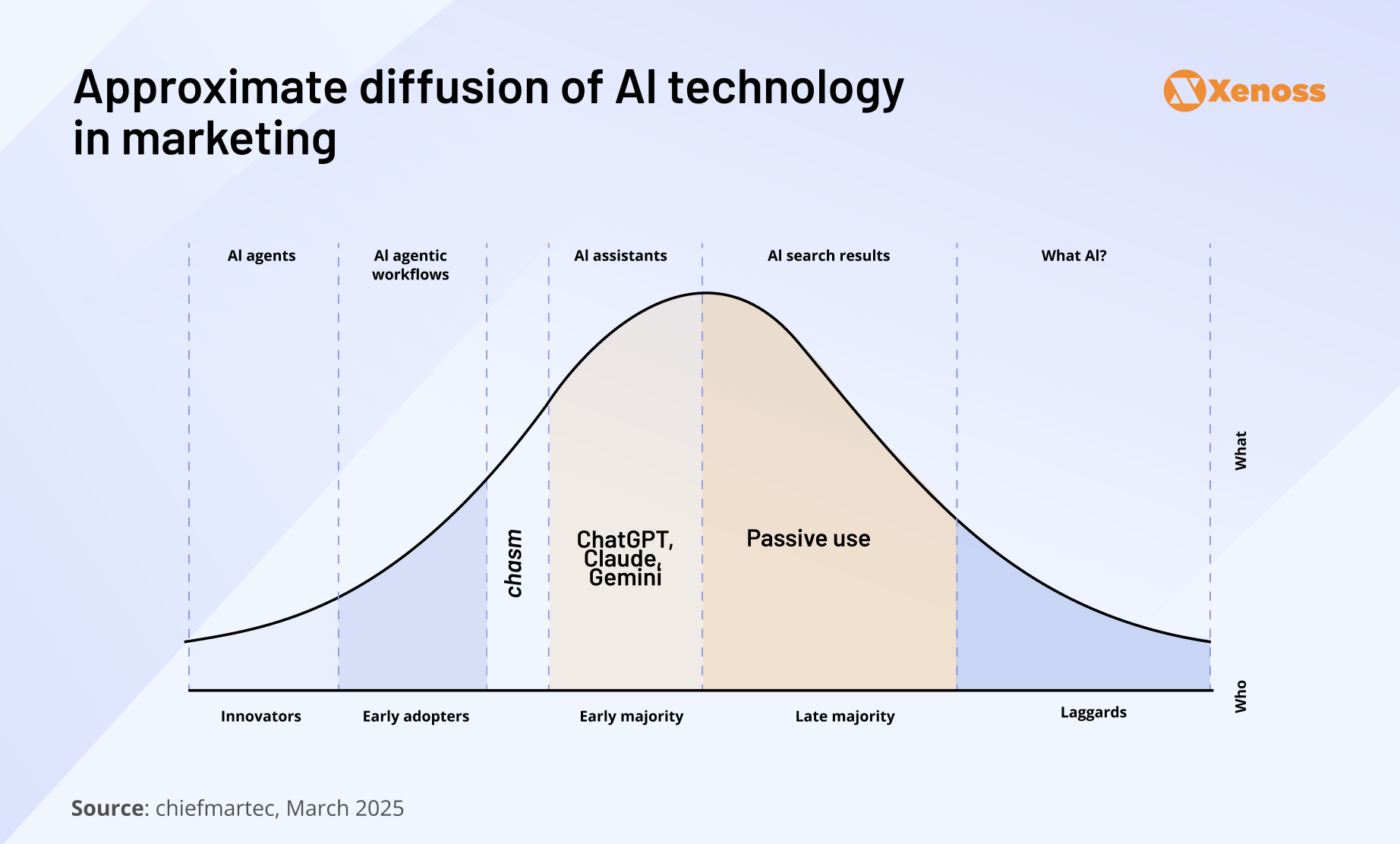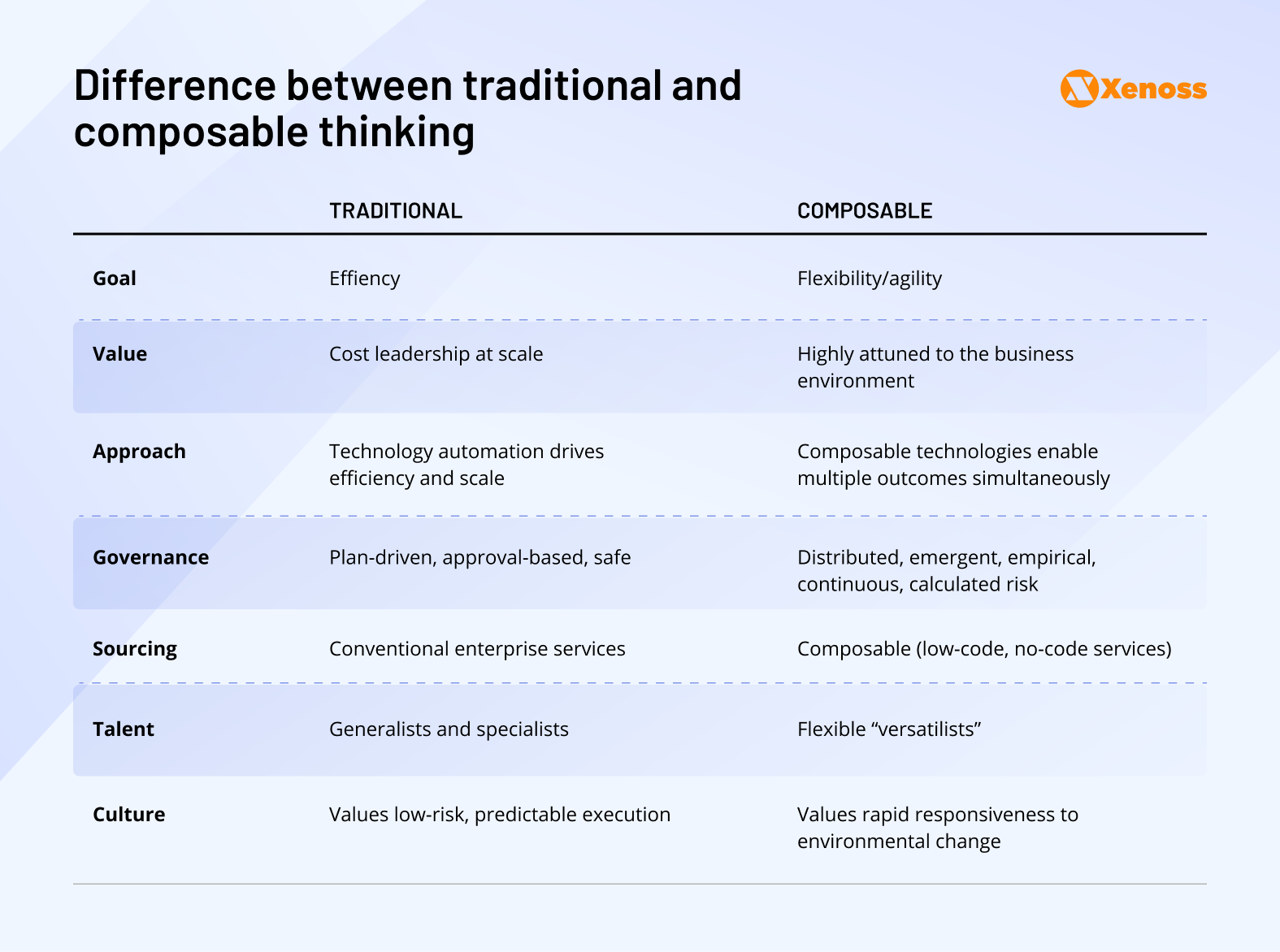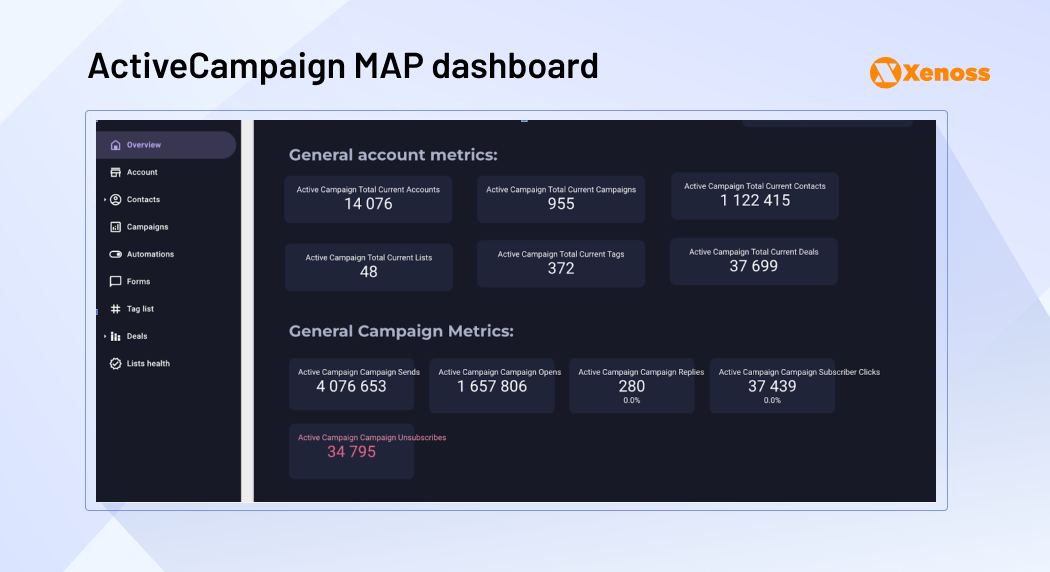If MAP is working, why would anyone want to abandon it? This is a no-brainer. Change is costly and uncomfortable. However, when competitors make bold moves and the market requirements change, standing still becomes the greater risk. That’s exactly what’s happening in the world of MAPs today.
MAP abandonment rates are soaring as enterprises become more mindful of their tech spending in the era of AI and shifting customer demands. The Research In Action report reveals that 87% of companies are reassessing the functionality of their MAP, while only 14% are satisfied with their current one. The most common reasons for increasing MAP abandonment are the lack of innovation and the rising total cost of ownership (TCO).
According to the Martech Intelligence Report, MAPs have been the most frequently replaced marketing software systems for five consecutive years. The share of companies that abandoned MAPs increased from 24% in 2023 to 40% in 2024, representing a nearly 70% rise.
This blog post examines the key drivers behind the increasing MAP abandonment rates and unravels what’s next for enterprises considering MAP replacement. But does this mean that MAPs will soon cease to exist? Not exactly, at least when we take AI into the equation.
Three market forces that drive MAP abandonment among enterprises
Below are three major drivers that stimulate enterprises to abandon MAPs and seek other options to remain competitive.
Hyper-personalization with AI
AI-infused MAPs have the potential to become a central hub for hyper-personalized marketing activities, reducing the need for costly integrations. Thus, the deciding factors for enterprises to abandon their current MAPs can be:
- lack of full-fledged AI offerings
- simplified integration capabilities with AI tools
- a necessity for expensive workarounds to enable AI functionality
The findings from the State of Martech report prove that enterprises are already actively using AI in their daily operations:
- 54.2% of respondents use built-in AI assistants in their MAP and CEP as chatbots to communicate with customers and quickly find information.
- 72% of companies are already experimenting with AI for their marketing initiatives, applying it to many use cases (mostly content generation and ideation).

But that’s only the tip of the iceberg; AI is capable of so much more. Jon Miller, a co-founder of Adobe Marketo, in his blog post on the future of B2B marketing, admits that starting from 2025, MAPs will be entirely reimagined with the help of AI. He claims that AI-native architectures are one of the most desired options. AI-native MAPs will enable users to ingest their enterprise data and then create and execute highly personalized marketing campaigns entirely without human assistance.
Composable Martech stacks
Composability is another trend fueling MAP abandonment, as it’s promising to reduce infrastructure costs and deliver quick and high ROI. This trend is gaining ground across the entire Martech, in particular, in the delivery of composable DXPs. In its essence, it’s the process of selecting best-in-class tech components and, through APIs, creating software architecture tailored to meet your unique marketing goals. Composability also inspired the emergence of low-code and no-code software, which reduces development time and costs while increasing flexibility.

Therefore, the possibility of abandoning costly and monolithic MAPs to build a composable tech stack responsible only for essential MAP functions, with practically limitless integration possibilities, is going to change how enterprises perceive traditional MAPs. For instance, enterprises can implement smaller MAPs designed for SMBs but, with the help of additional integrations, achieve high performance at a lower cost than maintaining a single enterprise-grade MAP.
Vendor consolidation
Enterprises are reallocating their budgets and optimizing tech spending, which puts large-scale enterprise-level MAP systems under threat. Choosing only those vendors that bring the most value, or in other words, vendor consolidation, is one of the market fluctuations that encourages enterprises to switch to another MAP, develop it from scratch, or opt for tech composability.
According to the State of Enterprise Tech Spending report, 76% of enterprises plan on pursuing vendor consolidation in 2025. Survey respondents also emphasized that before adopting any software solution, they’ll need vendors to provide precise specifications on ROI and business value.
AI integrations, composable tech stacks, and vendor consolidation are mutually reinforcing market drivers. AI emphasizes optimization, cost reductions, and innovations. Technical composability and consolidation spring up to prepare the ground for the AI-driven marketing future.
Let’s move from general market drivers to operational issues that encourage MAP abandonment.
Why enterprises abandon MAPs: The breaking points
Daily struggles with an outdated MAP tend to pile up until a marketing manager reaches their breaking point, and the frustration often sounds like this Adobe Marketo review:
The product has served our business needs, but it’s been slow to keep up with features that its competitors roll out faster. I don’t see them as an innovator, theyʼre playing catch up.
Where exactly do these systems fall short? Here are five reasons enterprises rip and replace their MAPs.
#1. Inability to actively measure ROI
Investments in the MAP software increase YoY, but enterprises don’t see the promised value. The need for real, tangible, measurable ROI is there. In 2011, the bar for MAP implementation success was relatively low; it was sufficient for the system to ingest historical data and build generic email templates. Now, implementing successful marketing automation software requires real-time data processing, big data analytics, AI integrations, and feature-rich interfaces. Therefore, the need for new MAPs arises, those that can provide innovation at a reasonable price.
The GNW Consulting survey reveals that for Martech implementations to be deemed successful, the time to ROI should be around one to six months. In contrast, for failing implementations, there is often no measurable ROI, or it takes more than a year to see real results.
#2. Data centralization and integration issues
As specified by the Martech replacement survey, 47% of companies cite limited data centralization capabilities as one of the key factors driving marketing software replacement, in particular, MAPs. Data architectures that aren’t flexible enough to keep up with the increasing customer load disrupt marketing efforts.
Modern enterprises need scalable data pipelines that collect data from multiple sources and enable insightful data analytics. With AI features appearing in MAPs, data issues are putting even higher pressure on enterprises, as it’s critical to ensure high data quality and security. The 2025 State of Your Stack survey reveals that data integration is the major Martech management challenge for 65.7% of respondents.
#3. Reporting and analytics constraints
If MAP vendors provide limited data analytics capabilities, enterprises miss out on valuable insights that might alter their marketing strategy. For instance, with proper data analytics in place, marketing specialists can validate the effectiveness of their ad campaigns and stop pouring money into those that prove ineffective.
Traditional MAPs may have limited or insufficient data analytics functionality. For example, as suggested in this customer review on Adobe Marketo:
I’ve also found that reporting often needs a lift—it’s decent for quick overviews but underwhelming for deeper, customized insights. You’ll likely find yourself exporting data into Tableau or Python for serious analysis.

Deeper, customized insights are a key differentiator between innovative and traditional MAPs.
#4. Software integration issues
An outdated MAP system may hinder or complicate integration with modern tools, such as data enrichment tools and AI systems, limiting business growth. Lack of proper data synchronization between MAP and other essential marketing solutions (CRM, CDP, DXP, CMS) can also be an issue.
Seamless integrations eliminate data silos, reduce errors, as the datasets are automatically ingested into the MAP, and allow for near real-time or real-time customer data exchange. This way, enterprises can build 360-degree customer overviews and achieve better alignment between marketing and sales teams to close deals effectively.
#5. Failing cross-channel orchestration
Traditional email-focused MAPs are losing popularity, as there is a growing need for omnichannel functionality to track customers across all touchpoints, including social media, landing pages, SMS, webinars, physical stores, and chatbot conversations. Enterprises also point out that frequently missed features in MAPs include omnichannel and campaign personalization.
Consider this: a retailer installs AI-driven sensors in its stores to track customer behavior and analyze which product categories receive the most and least attention. This data can then be used to enrich marketing promotion campaigns for the least popular products and automatically distribute ads across multiple channels. With the help of AI, those messages can be targeted at specific customers based on their prior purchases, interests, and social media behavior.
That’s what enterprises strive for when considering replacing their MAPs and ensuring a clear ROI: innovative marketing campaigns fueled by a modern tech stack and seamless data pipelines. Plus, they value the capability to measure the business impact of those campaigns with the help of advanced analytics tools. Let’s discuss the paths they choose to achieve such a level of marketing effectiveness.
What comes next: Post-abandonment strategies enterprises are adopting
What’s next after the decision to abandon your current MAP? The most common solutions could be migrating to another option that suits your goals much better, developing a custom MAP, or opting for composable stacks that substitute the MAP functionality.
Among MAP post-abandonment strategies, platform migration and custom development represent the most significant strategic decisions enterprises face. Each requires distinct considerations and investment levels.
Platform migration specifics
The most common post-abandonment strategy is switching to another MAP. But how long does it take to migrate from one platform to another? Jonathan Kent, Chief Revenue Officer at Hyperscale, puts it this way:
Marketing automation platform migrations are complex, strategic initiatives that touch data, processes, integrations, compliance, and customer experience. Rushing through that in 30 (or even 60) days isn’t just unrealistic, it’s reckless. If a consulting firm promises to do it all in a month, that’s a red flag. If your internal team is in that situation, that’s a red flag too. The real solution? Plan ahead!
A general rule of thumb is to complete the platform migration within three to six months. This way, you can minimize disruption to your business workflow while ensuring a thorough migration of your key assets and data.
Here are key things to consider before, during, and after the migration period:
Step 1. Set clear goals and communicate them to stakeholders. Identify the key assets that need migration, outline how you will measure migration success, and assess all the risks associated with the migration process. Note that 58% of organizations that set measurable objectives for their Martech implementations and engage the C-suite throughout the process achieve ROI within six months.
Step 2. Compare different MAP vendors. To select a suitable MAP for migration, you should prioritize what’s most important for you (lead generation, data analytics, content optimization, AI/ML capabilities). You can create multiple comparison tables that list all the priorities for you, use industry reports that enumerate the pros and cons of different MAPs, or review customer reviews on G2 and Gartner.
Step 3. Audit data sources and break silos. For smooth data migration, locate all the necessary data across diverse sources and evaluate its quality dimensions (relevance, accuracy, integrity, timeliness, uniqueness). You should distinguish between the data that can be migrated (prospect records and activity, static lists) and the data that should be recreated (landing page templates, email templates).
Step 4. Identify critical integrations. Explore the integrations your desired platform offers and identify which ones you’ll need to work on separately. You can then build automated data pipelines that enable quick data delivery between systems and tools.
Step 5. Iterative platform migration. Migrate your data and content assets in phases, testing and evaluating at every step. At this stage, it’s also critical to map data in the destination platform to ensure data formats align. For instance, prospect names in your current MAP may be listed in the format Full Name, whereas your destination MAP has a format of First Name, Last Name.
Step 6. Maintain parallel system functioning. During migration and for some time afterward, your MAPs should work simultaneously on different features to minimize disruptions to your currently running marketing campaigns.
MAP development from scratch
Developing your custom MAP is an option if none of the existing solutions on the market meet your needs. If that’s an issue, review key aspects of the custom development process to help you decide on the right track:
High upfront investments. Custom solution development from scratch combines a best-of-breed tech stack to align completely with your business workflow, offering a potentially quicker ROI. But on the flipside, you’ll have to invest more time and money than you would in platform migration or optimization processes.
Skilled team composition. If you lack in-house tech specialists, you’ll need to assemble an expert team from external development professionals, preferably with Martech development expertise.
MAP feature map. Define the core features your MAP should include. The beauty of custom development is that the system feature set is entirely up to you. Include basic functionality such as lead management, nurturing, and campaign management, but also consider custom features like:
- deep-dive data analytics
- brand template designs for landing pages and emails
- native AI and ML capabilities trained on your enterprise datasets to make predictions and enrich marketing campaigns
MVP, PoC, and a full-fledged solution. Test the waters by deploying an MVP and PoC before proceeding to full-fledged development. In such a manner, you can iteratively add advanced features to the MAP and eliminate potential risks.
Scalable and composable architecture. Designing a custom MAP architecture on AWS, Azure, or Google Cloud is the ultimate starting point to capture all the relevant data (including structured and unstructured) from multiple marketing sources.
At the architecture stage, you can set up real-time and batch big data processing to handle increasing loads and funnel it into custom data analytics tools. To enable automated decision-making at scale, which is crucial for MAP systems, event-driven architecture serves as a foundation for real-time data pipelines.
By combining patterns of event-driven architectures (e.g., message queues such as Kafka, RabbitMQ, AWS EventBridge) with composable microservices architecture elements (e.g., orchestration tools such as Camunda, Temporal, and Apache Airflow), you can achieve enhanced system performance, resilience, scalability, and stability during periods of peak demand.

Privacy- and security-by-design. Prioritize security and compliance with GDPR, CCPA, PCI DSS, HIPAA, or any other industry-specific regulations, laws, and standards from day one. A skilled development team considers role-based access controls, data encryption, anonymization, and pseudonymization strategies during the planning and design stage.
Success metrics: What works in post-abandonment implementations
What’s most important after you start working with your new MAP is consistently tracking
success. For that purpose, focus on:
- Custom KPIs. Depending on the goals you set before MAP migration or development, you should define your unique KPIs to measure (such as conversion rate and open or click rates) to evaluate your success. Additionally, track over time whether your marketing team is using all the platform features and whether your feature set is sufficient or insufficient.
- (Responsible, accountable, consulted, informed) RACI matrix. By developing a comprehensive RACI matrix, which identifies who is responsible for different processes within your migration or development project, you can ensure accountability when measuring the project’s success.
- Team training. The top lessons from failed Martech rollouts include the need for comprehensive team training (66% of respondents). Help your team grasp the essence of the new platform more quickly and deliver the expected results.
- Change management strategies. Organizations reporting fewer challenges with change management and cross-functional misalignment are more likely to achieve faster and longer-lasting adoption of their new MAP. Establish a deep-rooted culture of change within your organization by clearly communicating it as a strategic vision and supporting your team throughout the change process.
Building or migrating is a question of your current priorities. Define the core reason for MAP abandonment first. Is it a data integration issue? You can resolve it by auditing your enterprise data management processes and migrating to a more mature MAP platform that employs advanced data orchestration techniques.
Or is it a lack of advanced functionality, integrations, and AI capabilities that’s triggering your MAP abandonment? Then your go-to option can be custom MAP development or a composable tech stack. Discover from the case studies in the next section how different organizations approached MAP abandonment.
Enterprise abandonment case studies: When MAPs fail beyond repair
Among 200 people surveyed by GNW Consulting, 31% of respondents admitted that their recent Martech implementations had failed or delivered neutral results. The major risks of failure are:
- Revenue loss. A higher average contract value (ACV) combined with the purchase of costly technology equals a greater risk for a business. Thus, to achieve post-implementation ROI, enterprises should carefully plan their MAP migration, development, or optimization strategies.
- Team churn. Failed MAP implementations can result in marketing specialists either quitting or being fired; 42% of respondents reported that failed implementations led to employee turnover.
To avoid such outcomes, the following companies have thoroughly evaluated their as-is state to define which MAP migration strategy would be most appropriate for their businesses.
Case #1. MAP migration combined with vendor consolidation
A US-based SaaS company, offering design and brand management services, decided to migrate from Salesforce and Adobe Marketo to HubSpot. The company needed eight FTEs to administer their growing tech stack and still struggled with cross-functional misalignment between sales, marketing, and operations teams. Here are the specifics of this migration project:
- Timeline: The project took 90 days to implement a new MAP and consolidate all Martech tools.
- Strategy: The company adopted HubSpot’s Marketing, Sales, Service, and Operations Hubs to replace its legacy stack.
- Lessons learned:
- The technology stack should align with the business workflow, not vice versa
- Tool sprawl increases costs and decreases business value
- Results of MAP migration and vendor consolidation:
- Around $77,000 saved annually
- 50% reduction in technology expenses thanks to the consolidation of sales, operations, and marketing solutions
- Faster sales cycles
Case #2. From traditional MAP to composability
Another US-based B2B SaaS organization that provides diverse AI development services, abandoned Adobe Marketo and built a composable stack instead. Their marketing team had issues with the product’s usability, slow processing speed, and obsolete data management approaches. Let’s take a closer look:
- Timeline: Abandoned costly Marketo license in 2023 and launched a composable setup in less than 2 weeks.
- Strategy: Built a modular stack, consisting of: Iterable (messaging), Contentful (assets), Tray.io (workflow), Salesforce CRM.
- Lessons learned:
- Monolithic MAPs have limited flexibility
- Composable systems require stronger RevOps but deliver enhanced agility
- Results of building a composable stack:
- Campaign personalization improved
- Messaging costs were 10 times lower
- Marketers gained speed and control
These cases demonstrate that the era of Frankensteined Martech stacks and monolithic MAPs is coming to an end, with modern companies prioritizing omnichannel personalization, usability, and data processing speed. Enterprises that evaluate their current workflows, clean up data debt, and choose scalable, integration-ready tools are better positioned to avoid revenue loss and retain top talent.
Navigating the MAP market’s future
In the near future, the MAP market will be completely redefined. Traditional MAPs will either have to adapt and change fast or experience increasing customer churn. Composability, AI-enabled hyper-personalization, and vendor consolidation are three key pillars that drive market progress. We’ll likely witness the emergence of new MAP vendors with AI-native architectures, seamless cross-channel orchestration and personalization, and enhanced capabilities for data and third-party integrations. And they won’t cost an arm and a leg while offering so much more than legacy MAPs from the 90s.
To remain competitive and make marketing a strategic driver at your organization, start taking the first steps towards modernizing and consolidating your Martech stack, with MAP at its center. Analyze how your MAP contributes to marketing outcomes, highlight inefficiencies, and outline a transformation roadmap that shifts your stack from rigid and monolithic to modular and insight-driven.


